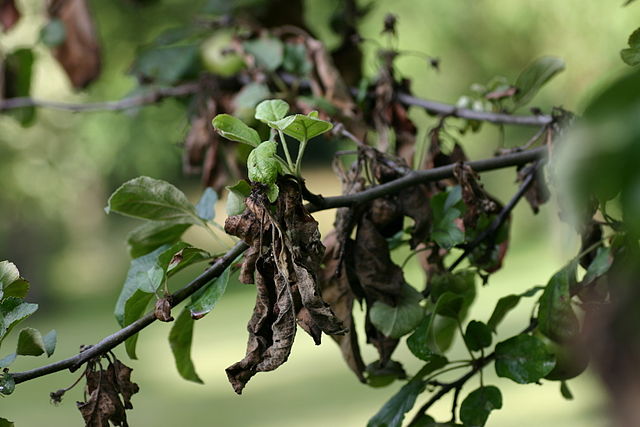This is the sixth part of a series on winter tree diseases and disorders. This article examines fire blight.
Introduction
During the winter months, many of the fungal pathogens that affect trees enter dormancy. The pathogens overwinter on their hosts or in the soil, awaiting spring’s arrival. Despite the frigid temperatures, trees suffering from fungal diseases may still exhibit infection symptoms in winter, especially if the disease has advanced into its later stages. The following describes some of the most common diseases to overwinter on trees, and how they may be detected.
Fire Blight
Fire blight is a significant disease of various fruit trees. It is one of the most common diseases to afflict fruit trees in spring and summer. Apples, crabapples, and pears are especially prone to infection. Fire blight is caused by the bacterium Erwinia amylovora. The bacterium can infect the branches, twigs, leaves, flowers, and fruit of susceptible plants. Plants that are severely infected generally experience widespread foliar dieback. Infections that progress into the main trunk often result in plant mortality. Under optimal conditions, fire blight can reduce blooms and fruit yield, or eliminate fruit altogether for a single growing season.
Hosts
Fire blight infects over 130 plant species of the rose family. It most frequently infects apple, crabapple, firethorn, mountain ash, and quince. Infections also occur on cotoneaster, hawthorn, juneberry, loquat, pyracantha, raspberry, and serviceberry.
Symptoms of Infection
Initial symptoms of infection appear in early spring, as trees break dormancy, and resume growth. The ooze produced by the bacteria is one of the most conspicuous symptoms. The watery, white to tan liquid can be observed exuding from infected branches, twigs, and trunks. The ooze turns black or brown once it has been exposed to the air.
Infected flowers and flower clusters will appear damp, before drooping and shriveling. As the infection deepens, the flowers become discolored, turning brown or black. Flowers that have succumbed to infection will often remain attached to the tree throughout the growing season. Infections may be localized, affecting only individual flowers or flower clusters. Infected fruit turns brown or black, and becomes desiccated. The fruit may cling to the branch for several months, before being shed.
Young leaves, twigs, and water sprouts wilt, turning grayish-green, then bending downwards to form a characteristic crook. The leaves and tips of infected twigs darken to brown or black. Trees with multiple infected shoots may appear scorched. Infected leaves will often linger on the tree for the remainder of the growing season.
Cankers can be identified by small to large areas of dead bark that have been killed by the bacteria. Most cankers are miniscule, making them difficult to detect. The bark on branch and trunk cankers will brown or blacken. As the wood decays, the bark sinks inwards. Eventually, the bark may crack or peel. If the bark is removed, brown staining of the sapwood may be observed.
Management
- When planting, select cultivars that exhibit an increased resistance to fire blight. Resistant varieties of crabapple include ‘Adams’, ‘Adirondack’, ‘Camelot’, ‘Candymint’, ‘David’, ‘Dolgo’, ‘Lancelot’, ‘Pink Princess’, ‘Red Splendor’, ‘Silverdrift’, and ‘Tina’. Varieties of pear that are less susceptible to fire blight are ‘Bradford’, ‘Capitol’, and ‘Red Spire’. Most cultivars of apple are vulnerable to fire blight, though some are especially prone to infection. These include ‘Fuji’, ‘Gala’, ‘Golden Delicious’, ‘Granny Smith’, ‘Gravenstein’, ‘Jonathan’, ‘Mutsu’, ‘Pink Lady’, and ‘Yellow Newton’.
- Diseased twigs and branches should be promptly removed from infected trees. Prune infected twigs and branches in late winter, when the tree and bacteria are dormant. Dormant pruning will prevent the bacteria from being transmitted to other trees or plant parts. If pruning is required during the growing season, sterilize pruning equipment with a solution comprised of nine parts water and one part bleach. After pruning, safely dispose of the infected trimmings. Trimmings may be buried, or burned. Avoid composting diseased trimmings.
- If the main trunk has been infected, cull the tree and stump to eradicate the bacteria.
- Fungicidal applications may provide limited protection to blooms. Applications must be performed on open blossoms. The number of applications required is determined by the length of the bloom period. Administer applications at two to three week intervals until the blooming period has ceased.
- Vigorous plants are favored by the bacterium. As such, avoid excess nitrogen fertilization of plants during the growing season.
- Limit the irrigation of susceptible plants while they are in bloom. This will reduce the incidence of infection.
Photo courtesy of Sebastian Stabinger CC-by-3.0
